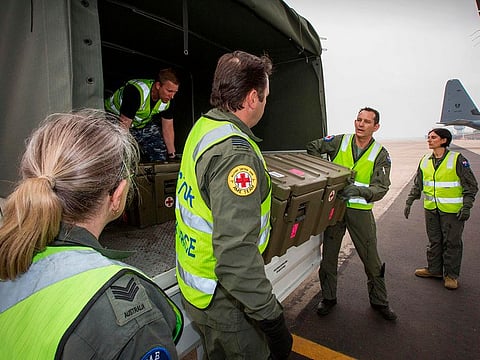Skin grafts: A look at efforts to save burned volcano victims
New Zealand volcano toll seen at 16; police plan to recover bodies on Friday

Sydney: An international effort is underway to save badly burned survivors of New Zealand's White Island volcano eruption, with the US tapped to provide 1.2 million square centimetres of skin and a dozen victims being flown to Australia for specialist care.
Here are four key questions about the work to treat the surviving patients.
Why is the skin needed?
Skin - the body's largest organ - holds our muscles, bones and internal organs together and helps regulate body temperature and synthesise vitamins. Damaged skin tissue can lead to complications like blood loss, shock and a heightened risk of infection.
Three days after the volcano exploded, most of the 29 survivors still hospitalised are in a critical condition and require "a lot of intensive care", according to New Zealand Ministry of Health director-general Ashley Bloomfield.
Some have burns to more than two-thirds of their bodies and a major challenge has been presented by internal burns, which for days prevented victims from identifying themselves.
New Zealand health official Pete Watson said the nature of the burns had been complicated by gases and chemicals released in the eruption.
"This has necessitated more rapid surgical treatment of these burns than is the usual case for thermal-only burns," he said.
Skin grafts - where healthy skin is taken from elsewhere on the victim's body, or from a donor - are one of the most important treatments for burns victims.
The applied skin acts as a plaster and helps to heal wounds and stop infections.
Where will it come from?
The skin will come from dead donors - many of whom lived on the other side of the world.
New Zealand put out a call for skin supplies from the United States and Australia, both of which sent a small amount of their stocks.
Authorities say more is still required - though less now that seven Australian survivors have been repatriated on military planes, and up to six more are expected to be flown home over the next 24 hours.
Australia has three donor tissue banks that will be relied up for its own patients, who are being sent to specialist burns units.
But donor skin is "always" in short supply, according to Stefan Poniatowski, who heads up one of the tissue banks.
And major disasters like the White Island eruption exacerbate that problem.
"Most of the skin is for day-to-day house fires, car fires, etcetera, so when big events happen it really does put strain on the system," he said.
How do skin grafts work?
Using skin tissue from deceased donors is a last resort - the ideal treatment is to transplant some of a patient's healthy skin to the burned area, says Poniatowski.
"Grafted skin really is the only course of treatment for patients... with burns to more than 50 percent of their body, because there is insufficient skin of their own to be able to retransplant onto their (wounded) sites," he told Australian broadcaster ABC.
Poniatowski said using donor skin was also the only option when patients were suffering from severe infection, because taking skin from elsewhere on the patient's body can create more areas of infection.
Specialists surgeons first remove damaged skin to expose healthy tissue, then implant and graft on the donor skin, he explained.
The new dermis will embed into the patient's dermis and allow their own skin to grow over the wound and heal.
Will the plan work?
With many of the patients so badly injured, officials are warning the public to brace for the death toll to rise.
Among them is Australian Prime Minister Scott Morrison, who said Thursday that "in the days ahead, there will be worse news".
But skin grafts can prove life-saving for burns victims, which is why health authorities are scrambling to quickly secure donor stocks.
Nevertheless, these initial surgeries represent just the beginning of a long road for patients, some of whom are expected to spend many months recovering.
Sign up for the Daily Briefing
Get the latest news and updates straight to your inbox


![Rachel Bloor kept her cool while guiding the snake out of the house. [Illustrative image]](http://media.assettype.com/gulfnews%2F2026-01-16%2Fmi5wlmq0%2Fpython.jpg?w=320&auto=format%2Ccompress&fit=max)


